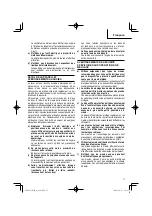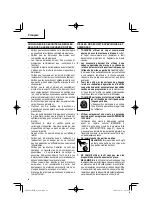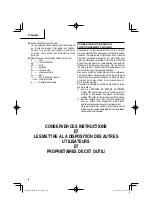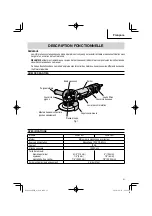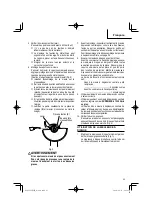
6. Mounting the wheel guard
Be sure to mount the wheel guard at an angle that will
protect the operator’s body from injury by a broken
wheel piece.
[How to attach and adjust the wheel guard] (Fig. 2)
○
Set the wheel ass’y to the packing gland.
○
Tighten M5 Hex. socket bolt to secure the wheel
guard while the lever is in closed position.
○
Perform the adjustment, of the wheel guard while
the lever is released. (Loosen M5 Hex. socket bolt
and readjust if the wheel guard does not rotate
smoothly.)
○
After adjustment, if grinder operation is required,
perform the operation only after setting the lever
in closed position.
○
Lubricate the sliding section of the set piece (B)
and the lever if the lever does not move smoothly.
Set piece (B)
M5 hex.
socket bolt
Lever
Fig. 2
WARNING
If the wheel guard is not attached properly, a
broken wheel may result in and cause death or
serious injury.
7. Thoroughly check that the depressed center wheel
is free of cracks, splits and other abnormalities
before mounting. Make sure it is
fi
rmly clamped and
has been properly mounted. Refer to page 11 of this
manual for Depressed Center Wheel Assembly and
Disassembly.
8. Test the grinder before using.
Before actually beginning the grinding work, test the
grinder by
fi
rst clearing the area of all other personnel.
Make sure the wheel guard is in place and that you
are wearing eye protection. Turn the grinder “on”, and
make sure the grinder runs smoothly and shows no
abnormalities.
Duration of the trial run is as follows:
When depressed center wheel is replaced
..................................................3 minutes or more
When starting daily work
....................................................1 minute or more
9. Use only properly rated depressed center wheels.
Use only depressed center wheels rated at
13300/min or more.
Using a depressed center wheel rated less can lead
to wheel disintegration during operation and cause
serious bodily injury.
10. Check the push button.
Make sure that the push button is disengaged by
pushing push button two or three times before turning
on the grinder. (Fig. 5)
GRINDER OPERATION
1. Hold the grinder
fi
rmly by its housing and side handle
(Fig. 1).
The grinder produces a counterforce which must be
controlled by
fi
rmly holding onto the grinder.
2. Turn the grinder “on”. (Fig. 3)
To switch on, slide the o
ff
-lock lever in the direction
of
Ⓐ
and press the switch lever (2 locations) in the
direction of
Ⓑ
as shown in Fig. 3. Release the switch
lever to switch o
ff
.
O
ff
-lock
lever
Switch lever
Ⓑ
Ⓐ
Fig. 3
3. Use light grinding pressure.
There is no need to press hard when grinding. Usually
the grinder’s own weight is su
ffi
cient to allow the
required light contact with the surface to be ground.
Do not apply the grinding wheel strongly to the grinding
surface. The grinder makes use of electronic circuit,
so during application of load rotates at high speed,
so ample grinding e
ff
ect can be obtained by applying
light pressure. If a strong grinding pressure or other
abnormal load is applied, the overload protection
circuit will operate and make the grinder stop rotating,
so please stop applying load immediately. Following
this, switching the power OFF and then ON again, will
cause the rotation to increase to the regular speed.
10
English
0000G12BYEQ̲metabo.indb 10
0000G12BYEQ̲metabo.indb 10
2020/06/15 14:18:15
2020/06/15 14:18:15

















